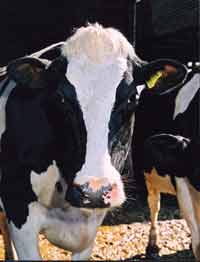Boosting cow fertility in wales

Maintaining cow fertility is arguably more difficult in modern Holsteins. However, good management can overcome many of the challenges
Letting calving index slip from under 400 to 460 days cost North Wales farmer Steve Jones £40,000 in lost milk sales alone as dry cow management and heat detection suffered.
Mr Jones, who with his wife Kim runs 140 pedigree Holsteins at Moreton Farm, Wrexham, admits he took his eye off the ball when he switched to organic farming.
“I went to sleep a bit,” he told farmers attending a cow fertility seminar on his 109ha (270-acre) unit. “The milk price was good and I tended to let service dates, dry cow management and trace elements slip a bit.”
More and more cows had extended lactations, and the 9000 litre a cow potential annual yield indicated by NMR records slumped to 8000 litres at 4.04% butterfat and 3.36% protein.
Also in the back of his mind was the perception, based on widespread hearsay evidence, that Holstein cows were more difficult to get back in calf, particularly on an organic system.
But the sixth-generation farmer had decided to convert to organic farming because, after 25 years on a conventional system, he was bored and wanted new challenges.
Correcting the fertility problem was just the sort of challenge he was looking for. To get help he turned to Neil Blackburn and Sam Evans of Kite Consulting and Liverpool University School of Vet Science.
Mr Evans told the seminar, organised by Organic Centre Wales and Farming Connect, that the modern Holstein cow was not, as many claimed, intrinsically less fertile than other breeds.
But she tended to exhibit fewer, more subtle and short duration signs of bulling, often at night, so heats could be easily missed, particularly as farms employed fewer people.
“Good detection is essential,” Mr Evans said. “Conception rates are also affected by things like the pressures of peak lactation, nutrition, condition score and housing. If there is a problem you should ask yourselves whether the Holstein or your herd management is at fault.”
He emphasised the importance of record-keeping as a means of detecting heats and failures to conceive. It might also be worthwhile investing in one of the various heat detection aids on the market, such as pedometers, which Mr Jones planned to do. “The technology is out there and can make a significant contribution to improving fertility.”
Mr Evans also warned that, if there were doubts about whether a cow was bulling, it could be false economy to try reducing the number of semen straws used. Serving a cow twice might cost £32, but it might be worth £125 in milk sales.
“I am not bothered if three straws a cow are used. If the semen isn’t there she can’t get in calf,” he insisted. Neil Blackburn said the general standard of management at Moreton Farm was excellent, and Mr Jones had the right mindset to make a success of organic conversion, which was completed in 2002.
But by letting service dates slip he had lost the advantage of inseminating after the release of high-quality eggs produced when cows were dry and not under the stress of early lactation. The aim should be to serve cows 42 days post-calving.
Under advice Mr Jones had also changed the way he used minerals so trace elements were included in the total mixed ration fed outside the parlour.
He had also included stock feed potatoes to boost ration energy level. Extra cereals were avoided to reduce the risk of feet problems.
Mr Blackburn warned visiting farmers not to let cows get over-fat before calving. Fat cows had lower intakes and, because they were genetically programmed to produce milk, they did so by using body reserves. “This means it can take two or three months longer to get them back in calf.”
Mr Jones now used home-grown straw to bulk up the dry cow winter ration, and controlled grazing in summer, to ensure a condition score of 2.5 at calving.
Management changes made had already produced results. In the three months to November 2008 it required an average of 2.41 services to get conception, there was 25% conception to first service and the days to conception figure was 178.
But in the three months to February 2009 the corresponding figures were 2.12 services, 33% first service conception and 147 days to conception.
